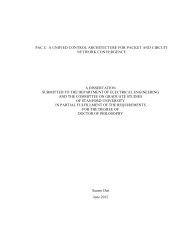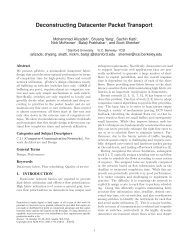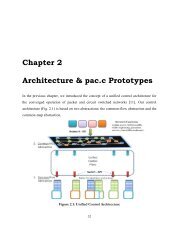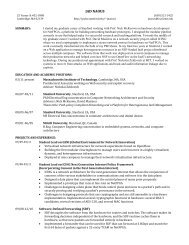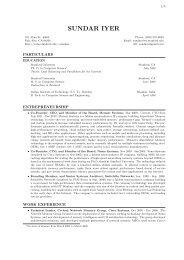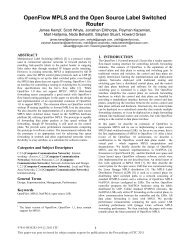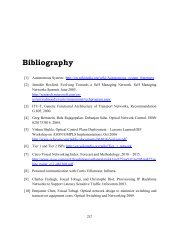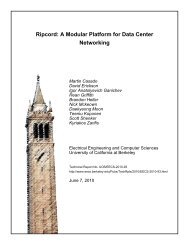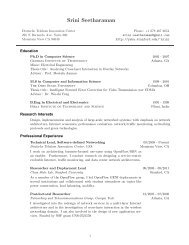Chapter 5 Introducing SDN Control in MPLS Networks - High ...
Chapter 5 Introducing SDN Control in MPLS Networks - High ...
Chapter 5 Introducing SDN Control in MPLS Networks - High ...
You also want an ePaper? Increase the reach of your titles
YUMPU automatically turns print PDFs into web optimized ePapers that Google loves.
177In essence, this usage model is simply IP-rout<strong>in</strong>g-with-labels, and is a holdover fromthe days when it was faster to do a lookup on a fixed 20-bit label than a variable length IPaddresses. Today, it has found use <strong>in</strong> <strong>MPLS</strong>-VPNs, where the <strong>MPLS</strong> label-stack is usedto deliver full mesh connectivity with address-space isolation. The outer label identifiesthe dest<strong>in</strong>ation-router (PE) and the <strong>in</strong>ner label identifies the VPN VRF <strong>in</strong>stance. The pathto the PE router is determ<strong>in</strong>ed via IP rout<strong>in</strong>g, and forward<strong>in</strong>g is performed us<strong>in</strong>g theouter-label. We will discuss this <strong>MPLS</strong> use-case <strong>in</strong> the <strong>SDN</strong> context <strong>in</strong> Sec. 5.4.5.1.2 <strong>MPLS</strong> Flow ModelIn the flow-based usage-model, LSPs are actually set-up <strong>in</strong> the network by head-endrouters (also called Label Edge Routers). Packets are classified <strong>in</strong>to FECs. All packets <strong>in</strong>the same FEC are forwarded equivalently via an LSP whose path can be determ<strong>in</strong>ed<strong>in</strong>dependent from regular IP rout<strong>in</strong>g (Fig. 5.4). Path calculation is done dynamically bythe head-end router or offl<strong>in</strong>e by a management system. And it is typically signaledexplicitly from the head-end to all other routers (LSRs) along the path us<strong>in</strong>g a signal<strong>in</strong>gprotocol like RSVP. Label distribution is therefore typically downstream-on-demand andordered [106]. Importantly <strong>in</strong> this usage model LSRs do not make <strong>in</strong>dependent rout<strong>in</strong>g/forward<strong>in</strong>g decisions on packets. Once an LSP is set-up and the LER has mapped an FECto an LSP, packets are forwarded as part of flows (FEC+LSP).(a)(b)Fig. 5.4 <strong>MPLS</strong> Flow Model



